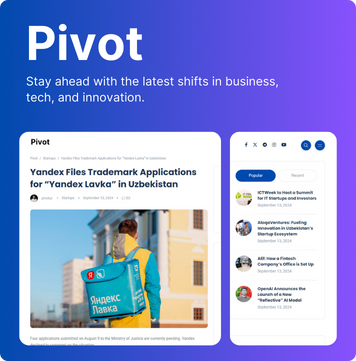
Ainura Khudaiberdieva, the owner of Burchak store, shared her experience of running a business on the Uzum Market marketplace and offered advice for aspiring sellers.
Ainura Khudaiberdieva’s experience on Uzum Market can serve as a useful guide for those looking to start their own business on the platform.
“I registered the Burchak store on the national marketplace on September 22, 2023 — that’s when I began my business after leaving my previous job. The initial capital for starting the business on Uzum Market was around 100 million UZS, which I believe is a reasonable amount for a start, though it can vary depending on scale. The main focus of the business is tableware and home goods. We chose this category for several reasons: first, it’s a growing category — home goods are always in demand and consistently rank among the top-selling items on the platform. People regularly buy household items and tableware, especially considering the growing number of new buildings. Buyers move into new apartments and strive to furnish them from scratch, which drives demand for this category. Secondly, despite its potential, the category remains relatively low in competition. Many sellers hesitate to work with tableware due to the challenges of delivering fragile items, but I see this as an opportunity to capture market share and meet customer needs.”

The popularity of items changes depending on the season and what we focus on in advertising. I regularly participate in the platform’s promotions because they significantly impact sales. In a competitive market, it’s hard to succeed without taking part in promotions. It’s important to approach promotion comprehensively: improving product listings, offers, and prices, and then using the “Boost to Top” feature to amplify results. Additionally, one shouldn’t forget about the advantages the marketplace offers, such as the ability to make purchases in installments for 3, 6, or 12 months.

“Our turnover on the marketplace from November to August amounted to around half a billion UZS. December was the most profitable month, and we are currently working to match those figures. It’s difficult to assess the growth percentage, as it largely depends on additional investments in the project. However, compared to the initial capital, we’ve achieved growth of around 400%.”

“I use the Uzum Sellers app daily. It’s convenient, though there are some functions I would like to see improved, such as adjusting invoices or reserving time slots.”
“I work with suppliers from China. Initially, we tried to establish relationships with Turkey, but that experience was unsuccessful, and now 100% of our partners are in China.”
The main mistakes of beginner sellers relate to several points:
- Lack of analytics. By this, I mean a poor understanding of how the chosen product category is developing. Many newcomers don’t use the available analytical tools to assess the growth and dynamics of their category. They don’t analyze which products are consistently in demand and which are only seasonally popular. Often, sellers base their decisions on personal preferences or trends without evaluating their long-term potential, leading to poor purchasing decisions and unsuccessful sales. A lack of planning, such as how much stock to buy and future sales projections, also falls into this category.
- Relying solely on the platform without additional tools to attract traffic. Here, I would recommend using tools that work best for your specific product category. For example, social media marketing works well for some categories, as it does for me with Instagram. We currently have almost 23,000 followers, and we create product reviews and promotional videos, which help with initial sales and gathering reviews. This then helps the product listing naturally rise on the platform, reducing promotion costs. For other products, like car tires, Instagram may not be suitable, and it would be better to use niche Telegram channels or collaborate with bloggers. It’s important to choose the right traffic channel and consider the specifics of each category.
“My strategy on the marketplace is simple — to make a profit while maintaining a good margin. This may seem basic, but many sellers lower their margins to compete, while I strive to keep mine high.”
“For example, I sold mugs for 125,000 UZS per piece, while competitors offered six mugs for the same price. Despite this, sales grew from 10 to 300 pieces per month, and I’m confident that this figure will continue to rise. The reason for the growth is that I chose a strategy of selling high-margin and unique products that not only meet practical needs but also satisfy buyers’ aesthetic preferences, making their homes cozier. In the digital age, people — whether bloggers or just homemakers — love to share content, cook beautifully, photograph it, and post it on social media. Aesthetics have become an important part of everyday life, and many seek tableware that not only serves its function but also looks beautiful. My strategy was to fill this niche — offering products that meet both practical and aesthetic needs, and people are willing to pay more for this. Additionally, thanks to consistent suppliers, I’ve been able to set competitive prices and earn customer trust. This is confirmed by hundreds of positive reviews and an established customer base.”




Leave a Reply